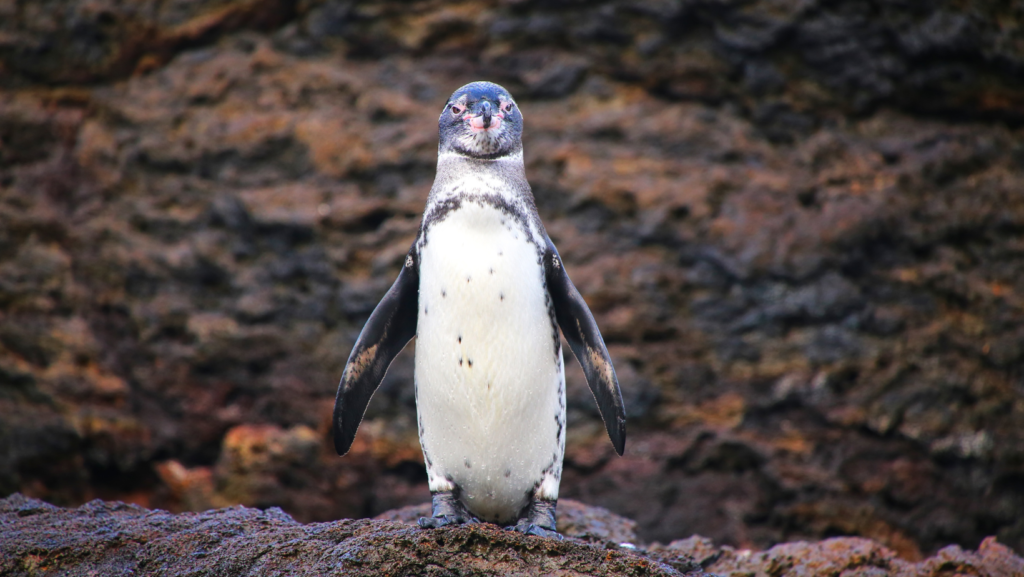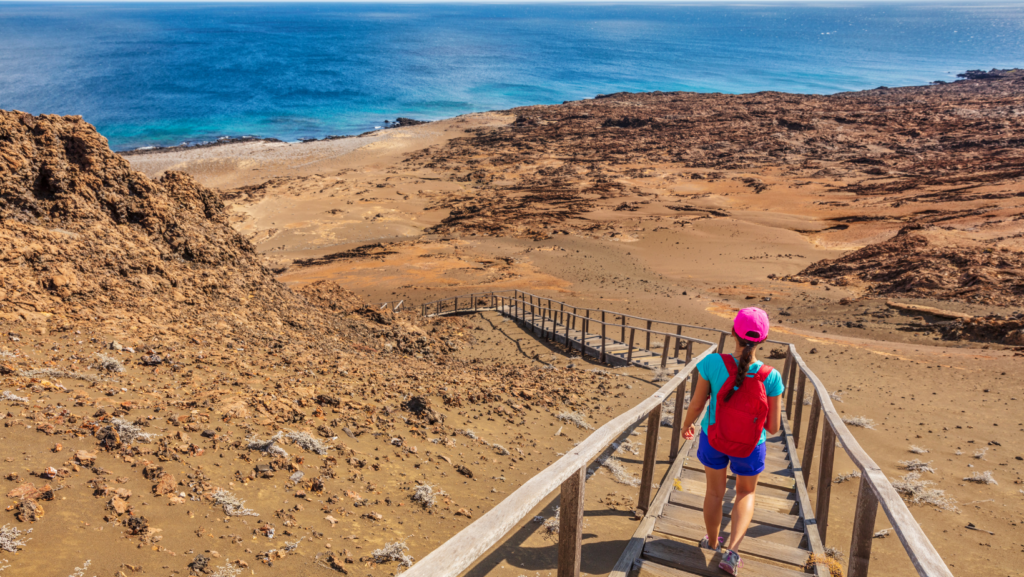
This island with its emblematic pinnacle is located in the northwest of Santa Cruz. Here you will have the opportunity to see one of the most beautiful landscapes in the Galapagos Islands while learning about the volcanic origins of the islands. Arriving in Bartolome, you will begin the walk along a path that will take you to the top of the island, through its 395 steps that end with a spectacular panoramic view of the island and its pinnacle. During the walk you will observe small lava tubes which are the product of the last eruption and where endemic vegetation such as lava cacti and tiquilla plants grow, usually surrounded by Darwin’s finches. Did you know that Pinnacle Rock is made of volcanic ash?
After the walk and having been impressed by the view from this point, you will enjoy a zodiac ride along the coast where, with a little luck, you will be able to spot the Galapagos penguin.
Dive site
The underwater Bartholome formations offer a bottom starting at 45 feet (15 m), followed by a wall disappearing into the depths. This is a good place to observe different species of sharks and other pelagic species. This dive site is rarely visited by diving cruises and daily diving excursion. Several species of fish can be observed at this site and, looking out to sea, it may be possible to observe hammerhead sharks, Galapagos sharks or manta rays.




Did you know that the island of Santa Fe is one of the oldest in the entire Galapagos archipelago ? Santa Fe has underwater rock formations dating back approximately 4 million years. Its relatively flat surface is the result of tectonic uplift. In Santa Fe you will find one of the most iconic endemic species of the Galapagos : the Santa Fe land iguana. A very characteristic iguana due to its yellowish color. Another endemic specie to this island is the Santa Fe rice rat, but don’t worry, it can only be seen at night.
During this day you will also be able to observe the largest species of opuntia cactus and the Galapagos hawk (the largest predator on the island), the blue-footed booby, the Galapagos sea lion, frigate birds (royal and magnificent) and the marine iguana. Once the walk is finished, you can swim in the Encañada, where it is also possible to snorkel with sea turtles, rays, sea lions and colorful fish while swimming in the warm and crystal clear waters of this island.
Dive site
The island of Santa Fe offers several sites for scuba diving. The first site is called the Punta and is composed of a pinnacle, the underwater floor of which is composed of stacked rocks forming a downward slope to a sandy bottom at approximately 91 feet (28 m). The second site, La Cueva, is also made up of rocks, with a network of “swim throughs” allowing you to have fun. Around Santa Fe, it is possible to observe a wide diversity of colorful fish, sea lions, red-lipped batfish and white-tip sharks. This island is only visited by daily trips from Santa Cruz. No diving cruise stops here.

This island is located in the east of Santa Cruz Island and is characterized by its incredible landscape. The tour begins with a walk on a trail through a forest of Opuntia cacti. You will also have to be careful where you step, because this island is home to a large number of land iguanas, the smallest in the archipelago!
On your walk you will also follow windy cliffs where you can spot red-billed tropical birds, swallow-tailed gulls, brown pelicans and the occasional frigate bird. The trail winds along the edge of the cliff for a few hundred meters. You will also come across the famous “single sea lion colony” : a heterogeneous collection of male sea lions, most of them old, who have lost their territories. Amazingly, they climb the cliff via rock steps. You can visit this island with a day tour from Santa Cruz and on some naturalist cruises.
Dive Site – Anchorage
This site is a shallow site, with a maximum depth of 25 feet (8 m) where it is possible to dive with young sea lions. This site is not very popular and visiting is sometimes prohibited when there are too many sea lions. This is a site where snorkeling and scuba diving are permitted.

Tours to Seymour North depart from Itabaca Channel, north of Santa Cruz Island. This island is located north of Santa Cruz Island and is known for its large colonies of blue-footed boobies and frigatebirds (the latter known as Galapagos pirates). Some naturalist cruises also stop on this island.
Arriving at Seymour North, you disembark on land and immediately begin hiking along a 1.5 mile trail. You will either follow the coast clockwise or head inland to first visit the blue-footed boobies colony. During this tour you will access the nesting sites of the largest chick colonies on the islands. At that point you will understand why Seymour is known for its rich wildlife. Get ready to spot land iguanas, marine iguanas, a colony of sea lions, lava lizards and pelicans ! As you progress along the trail, you will see several trees where male and female frigatebirds nest. Then the terrain becomes rocky and this is where you can observe the place where the spectacular blue-footed boobies nest. This species is fascinating for their mating dance in which they can dance for hours until finally captivating the female to nest together.
Dive Site
One of the sites of Seymour North is in the channel which separates the island of Seymour and Mosquera. This sandy channel features large stones cascading down to the middle of the channel. Sites have a maximum depth of 65 feet (20 m). The sandy bottom is perfect for observing Galapagos garden eels, rays, moray eels, dense schools of reef fish, but also different species of sharks such as whitetip reef sharks, Galapagos reef sharks and sometimes hammerhead sharks which come along the sandy bottom. This is a beginner site, often used at the start of a diving cruise, combined with the Mosquera islet which is located right next to it.
It is also possible to dive on the northeast part of the island, on a site with a shallower sandy part, then a wall going down to almost 90 feet (27 m) deep. This site has more current, which can sometimes be very strong, but is also ideal for observing pelagic species such as the occasional manta rays, hammerhead sharks, eagle rays.
This island can be dived from a diving cruise or with a day trip from Santa Cruz, because the navigation from the Itabaca channel is not very long (around 45 minutes).


Punta Pitt is located on the northeastern tip of the island of San Cristóbal. This is the only place in the archipelago where it is possible to observe the 3 species of boobies present in the Galapagos. The seafloor is composed of a mixture of volcanic rock, sandy bottom and small islets of coral reef. It is possible to do snorkeling and scuba diving. This site can be visited by a day trip from San Cristobal or on certain naturalist cruise itineraries.
Dive site
This is a good place to dive with sea lions, different species of rays, sharks and reef fish. The maximum depth of the sites is approximately 75 feet (23 m). Given the proximity of the rocky cliffs of the point, swell is often felt at the different places. This site is only dived by day trips. No diving cruise pass through this site.


